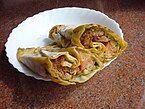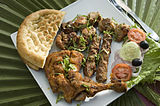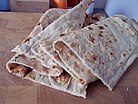ロティ
Roti/ja
 チャパティとして知られるフラットロティ | |
| Alternative names | Ruti |
|---|---|
| Type | フラットブレッド |
| Place of origin | インド亜大陸 |
| Created by | インダス文明 |
| Main ingredients | Atta flour/ja |
| Variations | チャパティ、バジュラ・ロティ、ジョワル・ロティ、チャワル・キ・ロティ、マッキ・キ・ロティ、ルマリ・ロティ、タンドーリ・ロティ、ラップ・ロティ、ロティ・チャナイ、パラタ |
ロティは、インド亜大陸発祥の丸い薄焼きパンである。これは、多くの南アジア、東南アジア、カリブ海、東アフリカ、東南アフリカ諸国で一般的に食されている。
これは石臼で挽いた全粒粉、インドではゲフ・カ・アタとして知られているものと、水を加えて生地にし、作られている。その決定的な特徴は、無発酵であることだ。対照的に、インド亜大陸のナンは、イーストで発酵させたパンであり、クルチャも同様だ。世界中のパンと同様に、ロティは他の料理に添えられる主食である。
語源
「ロティ」という言葉は、サンスクリット語の「roṭikā」に由来しており、「パン」を意味している。
種類
- マッキ・ロティ: トウモロコシ粉のロティ。サルソン・カ・サーグ(からし菜の煮込み)と共に供される、パンジャブの代表的な料理である。
- アッキ・ロティ: 米粉のロティ。すりおろした野菜とスパイスを加え、チャツネと共に供される、カルナータカ州で有名な料理である。
- タリピート・ロティ: マハラシュトラ州のロティで、バジュラ、ジョワル、米、ひよこ豆、スパイスで作られる。ヨーグルトやギーと共に供され、カルナータカ州でも人気がある。
- ミッシ・ロティ: チャパティに似たラージャスターン州のロティで、赤唐辛子、クミン、ターメリックなどのスパイスが加えられ、グレービーや野菜と共に供される。
- クットゥ・ロティ: ソバ粉のロティ。ジャガイモが入り、グルテンフリーで、ナヴラートリの断食中によく食べられる。
- パラタ: 小麦粉のロティ。プレーンなものや、ジャガイモ、カリフラワー、パニールなどの様々な野菜を詰めたものがあり、バターやカードと共に、あるいは単独で供される。
- ルマリ・ロティ: ハンカチのように薄く柔らかいロティ。アワディ、ムグライ、ハイデラバード料理で人気があり、グレービーと共に供されるのが最も良いとされる。
- グル・ロティ: ジャグリー(黒糖)と全粒粉のロティで、小さくて厚く、ミーティ・ロティ(甘いロティ)とも呼ばれる。
作り方
ロティは、小麦粉と水、そして好みで塩やバターまたは油を混ぜ合わせたものから作られる。これらを混ぜて生地を作り、寝かせるのだ。その後、生地を丸めて、麺棒で平らに伸ばしてロティを形成する。こうしてできたロティは、タヴァやフライパンで焼かれるのである。
バリエーション
-
インド亜大陸のロティ
-
シンガポールのロティ・プラタ、カレー添え
-
プレーンなロティ・パラタ
-
オランダにて、ゆで卵とスモークチキンを包んだスリナムのロティ・ラップ
-
チャパティが乗ったインドのターリー
-
インド料理店で他の料理と共に供されるタンドーリ・ロティ
-
インドでルマリ・ロティを準備するシェフ
-
ロティと供されるスパイシーな野菜
-
バナナを詰めたロティ
インド亜大陸
薄焼きパンやロティの多くのバリエーションは、インド亜大陸からアフリカ、オセアニア、マレー半島、アメリカ大陸に至るまで、世界中の多くの文化圏で見られる。ロティはインド亜大陸の伝統的な薄焼きパンである。通常、調理された野菜やカレーと共に食され、それらを運ぶ役割を果たすこともある。ほとんどの場合、小麦粉から作られ、タワと呼ばれる平らな、あるいはわずかに凹んだ鉄製のグリドルで焼かれる。伝統的に、ロティはミレット、トウモロコシ、ジョワル、バジュラ、さらには米の粉からも作られてきた。タンドーリ・ロティは、平らにした生地をタンドールオーブンの内壁に貼り付けて調理され、高温で素早く焼き上がる。チャパティはアタとして知られる全粒粉でできており、パラートと呼ばれる混ぜる道具で水、食用油、そして好みで塩を加えて生地にし、タヴァ(平らなフライパン)で焼かれる。パンジャブ語とサライキ語では「プルカ」、シンド語では「マーニ」として知られている。
スリランカ
スリランカには、「ポル・ロティ」(ココナッツ・ロティ)と呼ばれるロティの変種が存在する。これは小麦粉、あるいはクラッカン粉、そして削りココナッツから作られる。時には、調理前に刻んだ青唐辛子や玉ねぎが加えられることもある。これらは通常、他の種類のロティよりも厚く、硬い。これらは通常、カレーや特定の種類のサンボル、ルヌ・ミリスと共に食べられ、副食というよりも主食と見なされている。
スリランカで人気のもう一つのロティの変種は「コットゥ・ロティ」である。これは「パラタ」または「ゴダンバ・ロティ」で作られ、小さく、四角形または長方形に切り刻まれている。次に、四角い加熱鍋で野菜と玉ねぎが炒められる。卵、調理済みの肉、または魚が炒めた野菜に加えられ、数分間加熱される。最後に、切り刻まれた「パラタ」の断片が加えられる。これらは重い鉄製の刃やスパチュラを繰り返し叩きつけることで刻み混ぜられ、その音は遠くまで聞こえるほどである。使用される材料によって、野菜、卵、鶏肉、牛肉、羊肉、魚の「コットゥ・ロティ」といったバリエーションがある。時にはファストフードとして調理され、提供されることもある。
「ゴダンバ・ロティ」はスリランカで見られるもう一つの種類である。プレーンな「ゴダンバ・ロティ」はカレーと共に食べられるか、風味豊かな具材を包んで食べることもできる。
| Nutritional value per 100 g (3.5 oz) | |||||||||||||||||||||||||||||||||||||||||||||
|---|---|---|---|---|---|---|---|---|---|---|---|---|---|---|---|---|---|---|---|---|---|---|---|---|---|---|---|---|---|---|---|---|---|---|---|---|---|---|---|---|---|---|---|---|---|
| Energy | 1,245 kJ (298 kcal) | ||||||||||||||||||||||||||||||||||||||||||||
46.36 g | |||||||||||||||||||||||||||||||||||||||||||||
| Sugars | 2.72 | ||||||||||||||||||||||||||||||||||||||||||||
| Dietary fiber | 4.9 g | ||||||||||||||||||||||||||||||||||||||||||||
7.45 g | |||||||||||||||||||||||||||||||||||||||||||||
11.25 g | |||||||||||||||||||||||||||||||||||||||||||||
| |||||||||||||||||||||||||||||||||||||||||||||
| Other constituents | Quantity | ||||||||||||||||||||||||||||||||||||||||||||
| Water | 33 g | ||||||||||||||||||||||||||||||||||||||||||||
| Selenium | 53.7 ug | ||||||||||||||||||||||||||||||||||||||||||||
| †Percentages estimated using US recommendations for adults, except for potassium, which is estimated based on expert recommendation from the National Academies. | |||||||||||||||||||||||||||||||||||||||||||||
カリブ海地域
ロティはカリブ海地域全域で広く食されており、特にトリニダード・トバゴ、ガイアナ、スリナム、ジャマイカといったインド系カリブ人人口の多い国々で顕著である。元々はインド亜大陸からの年季奉公人によって島々にもたらされたが、ロティはこれらの国の豊かな食文化において人気の主食となった。カリブ海地域では、ロティは様々なカレーやシチューの添え物として一般的に食されている。ロティの伝統的な食べ方は、手でロティをちぎり、それを使ってカレーのソースや肉片をすくい取ることである。しかし、カリブ海地域では、ロティという言葉は、薄焼きパン(ロティ)そのものと、ロティを風味豊かな具材の周りに巻いた、より人気のあるストリートフードの両方を指すことがある。
ロティ・ラップは、ファストフードやストリートフードとして、ロティとカレーを組み合わせたカリブ海地域での商業化されたものである。この包む形式のロティは、トリニダード南部で生まれた。最初に作られたのは1940年代半ばで、後にサン・フェルナンドにハミングバード・ロティ・ショップを創業したサキーナ・カラマスによって考案された。このラップは、手軽に、そして外出先でも食事ができ、手を汚さずに済むため、便利であった。トリニダード・トバゴでは、鶏肉、コンク、ヤギ肉、牛肉、エビなど、様々な具材を包んだロティが提供されている。ジャガイモ、カボチャ、ほうれん草などの野菜を加えることもでき、また、ペッパーソース(ホットソース)とマンゴーチャツネが最も人気のある様々な地元の調味料も加えられる。ロティ・ラップは島中で急速に人気を博し、カリブ海地域の他の地域にも広まった。現在、このラップは単にロティ、またはただロティと称されている。その人気の高まりにより、最近では具材を包む薄焼きパンそのもの(ロティ)を「ロティ・スキン」または「ロティ・シェル」と呼ぶようになり、この慣習は現在、レストランと商業企業の双方で一般的である。西インド諸島全体で様々な種類のロティが食されている。特にトリニダード・トバゴ、ガイアナ、スリナムの人々の食生活に大きく取り入れられている。カリブ海スタイルのロティは主に小麦粉、ベーキングパウダー、塩、水から作られ、タワで調理される。特定のロティはギーやバターでも作られている。
トリニダード・トバゴ
| 料理 | 画像 | 概要 |
|---|---|---|
| サダ・ロティ | これは白い小麦粉で作られたプレーンなロティである。最も簡単に作れるロティであり、トリニダードで最も一般的に食されているロティである。現地の人気の朝食の選択肢であり、様々なカレー風味の肉料理や野菜料理と共に楽しまれている。この種のロティは、トリニダード人にとって朝食と夕食の両方で消費される主食である。 | |
| パラタ・ロティ | 
|
バター(通常はギー(澄ましバター)だが、どんなバターでも使用可能)を塗って層状にしたロティである。両面にギーを塗り、インド料理やパキスタン料理で使われる丸くて平らな金属製の鉄板「タワ」で焼く。これにより、ロティは外側がパリッとし、軽く焦げた小さな斑点ができる。ロティがほぼ焼き上がる頃、調理人はタワの上でロティを叩き始め、それによってロティは軽くてフレーク状になる。「パラタ・ロティ」はプレーンなロティよりも濃厚で風味豊かである。「パラタ」はほとんどどんな添え物とも合う。他のロティと同様に、カレーやシチューと共に一般的に食されている。また、伝統的に目玉焼きや卵料理、そして一杯の紅茶と共に食されている。トリニダードでは、「パラタ」は、そのロティがボロボロに破れたシャツに似ていることから、口語的に「バスアップ・シャット」(破れたシャツ)と呼ばれている。 |
| プーリー | 
|
これは2枚の生地を一緒に伸ばして焼くロティである(伸ばした後、直接熱い油で揚げる。一部の人は、まずタワで半分ほど調理してから揚げる(これによりプーリが吸い込む油が少なくなるため)、カダイで揚げる)。この種のロティは、子供が生まれた時やムリティボジ(テヘルヴィ/追悼式)で特別なハルヴァと共に食される。 |
| ダルプリ | 挽いた黄色のエンドウ豆、クミン(ジーラ)、ニンニク、コショウを詰めたロティである。エンドウ豆はアルデンテになるまで茹でてからミルで挽く。クミンは黒くなるまで焙煎し、これも挽く。詰め物をロティ生地に押し込み、閉じ込める。平らに伸ばすと、具材がロティ全体に均一に広がる。タワで焼き、調理しやすくするために油を塗る。この種のロティは、様々なカレーと共に食されるのが最も一般的である。また、ラップ・ロティを作る際にも選ばれるロティである。 | |
| ラップ・ロティ | 
|
肉と野菜のカレーをダルプリ・ロティの中に折り畳んで作った人気のラップである。カレーやシチューには、主要な肉の具材の他に、フィラーとしてジャガイモやヒヨコ豆が含まれることが多く、ベジタリアン向けの選択肢も一般的である。人気のある具材には、カレー風味のチキン、コンク、ヤギ肉、鴨肉、牛肉、エビ、そして野菜がある。ペッパーソースやマンゴー・チャツネといった様々なオプションの調味料も一般的で、これらが最も人気がある。 |
| アルー・プーリ / ポテト・プーリ | ダルプリに似たロティだが、ダル(豆)の代わりにアルー(ジャガイモ)が使われている。アルーは茹でて挽き、スパイスと調味料を加えてから生地に閉じ込める。このアルーの詰め物は、アルー・パイやアルー・チョカを作る際にも使われる。 |
ガイアナ

Dosti roti is common in Guyana. A small amount of fat is placed in each piece of dough before it is rolled out to make the roti softer. Usually, vegetable oil is used, but butter, or margarine can also be used. Ghee is not used in everyday cooking, but is used on special occasions, especially amongst Hindus. The roti is usually clapped by hand or beaten a bit, hot off the tava, so it softens but does not break.
- A good roti in Guyana is very soft, with layers (almost like pastry layers if possible), which remains whole.
- The type of roti is determined by what is placed in the dough before it is rolled out. Various types include dhalpuri, aloo (potato) roti, and even sugar (to keep the kids busy, while the mother finishes cooking).
- In Guyana, a rolled-out, thin, flat dough like a roti that is deep-fried in ghee is called a puri. Therefore, a dhalpuri is not really a puri.
- Another item prepared like roti is bake or bakes or floats. A Guyanese or Trinidadian fry bake seems to be more similar to an Indian puri. A bake is made with butter or margarine and has a different ratio of flour to fat. It is made much quicker than roti and is usually made in the mornings. Dough is rolled out and cut into shapes or rolled into small rounds. Guyanese bakes are fried, but bakes from other parts of the West Indies can be baked in an oven. Bakes are usually paired with a quick fry-up for breakfast or dinner, stewed saltfish, or eggs ("western" style, with onions, tomatoes, green peppers). Bakes are also made in other parts of the West Indies, including Trinidad, Barbados, and St. Vincent. In Trinidad and Tobago, a "bake and shark" is a popular street-food sandwich in which fried shark is placed between two halves of a sliced bake with local condiments. Pepper sauce, shado beni, garlic sauce, tamarind, and mango chutney are most common, as well as lettuce, tomato, and cucumber for fillers.
Suriname
In Suriname, roti refers mainly to dhalpuri or aloo puri. It is most often eaten with curried chicken. As in Trinidad and the West Indies, roti can also refer to the stuffed roti wrap. This dish is usually eaten out of hand. Due to a mass emigration of Indian Surinamese in the 1970s, roti became a popular take-out dish in the Netherlands. It usually includes chicken curry, potatoes, a boiled egg, and various vegetables, most notably the kousenband or yardlong bean. Another variation includes shrimp and aubergine. The meat with gravy, potatoes, egg, and yardlong beans are served side by side on a plate, with the aloo puri folded in fours on top.
Southeast Asia


In Indonesia and Malaysia, the term encompasses all forms of bread besides the traditional Indian breads (like roti canai) including Western-style bread (like roti john), as well as bing of the Chinese.
In Thailand, โรตี is a popular street food that can be eaten as a dessert or as a side dish. Some Thai curries can also be accompanied with a side of roti, primarily Southern Thai curries.
In Cambodia, រ៉ូទី is a dessert that is sold as street food. It is similar to both a crêpe and paratha.
South Africa
Roti was initially introduced to South Africa by Indian migrants during the 19th century, and subsequently became incorporated into Durban cuisine. It is widely eaten by the Indian communities living in South Africa, and is either eaten as a flat bread or a wrap with locally made curries.
Roti is also often eaten in Cape Coloured and Cape Malay Communities. Two types of roti are eaten: chapati/flat roti and paratha/flaky roti. Flaky roti is also called Malay roti. When eaten with a curry filling, usually mutton, chicken or mince, the roti is called a Salomie. A roti gatsby is a popular takeaway dish where the bread of the filled gatsby, a popular sandwich is replaced several rotis and folded.
Mauritius
Similarly as with other countries that were part of the Indian diaspora, roti was introduced to Mauritius by Indian migrants/indentured labourers during the 19th century, and has since been a staple of Mauritian cuisine and a common street food. Roti generally refers to farata (a local pronunciation of paratha), a pancake made of wheat flour and water; other variants include dholl puri, which is layered, and stuffed with boiled and ground dal/split peas, and ti puri, a smaller roti that is fried and usually served with seven different curries.
Iran
In Iran, the two variants of roti are called khaboos and lavash. These two breads (the former of which is almost exactly prepared like Indian roti) are quite similar to other rotis.
Elsewhere
Roti shops are now abundant in Trinidad and Tobago, Guyana, Suriname, Jamaica, the United States, Canada, the United Kingdom, and the Netherlands. Owing to Canada's considerable immigrant populations from both South Asia and the Caribbean, roti and its variants are popular there. As Indo-Caribbean people moved to North American cities such as Toronto, New York City, Miami, Los Angeles, and Montreal, they exported with them the wrapped version of roti. A distinct Toronto offering is the "East Indian roti", a variation on the stuffed roti from the West Indies. In some of these cultures, rotis are also being used in the place of pita bread when making burritos, quesadillas, or any other kinds of wraps.
関連項目
Notes
| この記事は、クリエイティブ・コモンズ・表示・継承ライセンス3.0のもとで公表されたウィキペディアの項目Roti(8 May 2025, at 22:31編集記事参照)を翻訳して二次利用しています。 |
- Roti
- Balochi cuisine
- Bangladeshi cuisine
- Bengali cuisine
- Bihari cuisine
- Fijian cuisine
- Flatbreads
- Gujarati cuisine
- Guyanese cuisine
- Hindu cuisine
- Indian breads
- Indian cuisine
- Indo-Caribbean cuisine
- Indonesian breads
- Iranian breads
- Jamaican cuisine
- Kashmiri cuisine
- Malaysian breads
- Mauritian cuisine
- Nepalese cuisine
- North Indian cuisine
- Pakistani breads
- Pashtun cuisine
- Punjabi cuisine
- Punjabi words and phrases
- Sindhi cuisine
- South Asian cuisine
- Sri Lankan breads
- Surinamese cuisine
- Trinidad and Tobago cuisine
- Unleavened breads
- Uttar Pradeshi cuisine
- Vegetarian cuisine
- Vegetarian dishes of India












